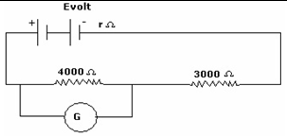Current Electricity - Online Test
Q1. In a Wheatstone’s bridge, P = 9 ohms, Q = 11 ohms, R = 4 ohms and S = 6 ohms. How much resistance must be put in parallel to the resistance S to balance the wheatstone bridge?
Answer : Option A
Explaination / Solution:
Let a resistance M be put in parallel to S and the equivalent resistance of the parallel combination be X. In the bridge balance condition
In the parallel combination of S and M,

Q2. In the measurement of resistance by a metre bridge, the current is necessarily reversed through the bridge wire to eliminate
Answer : Option D
Explaination / Solution:
The connecting metal strips include a small resistance in the circuit called the end resistance.
On reversing the current, the end resistance tends to get cancelled out.
Q3. If 2% of the main current is to be passed through the galvanometer of resistance G, the resistance of shunt required is
Answer : Option C
Explaination / Solution:
The current Ig through a galvanometer of resistance G is 0.02 I where I is the main current.
The shunt resistance S is calculated as follows.

Q4. In the figure, when an ideal voltmeter is connected across 4000 ohm resistance, it reads 30 volts. If the voltmeter is connected across 3000 ohms resistance. It will read


Answer : Option B
Explaination / Solution:
An ideal voltmeter does not draw any current. Therefore the resistances 4000 Ω and 3000 Ω are in series. The current in the circuit
The potential difference across the 3000 Ω resistor

Q5. According to Ohm's law
Answer : Option C
Explaination / Solution:
Ohm’s law states I is proportional to V.
This holds good at steady temperatures and for the flow of constant current.
Q6. Drift is the random motion of the charged particles within a conductor,
Answer : Option A
Explaination / Solution:
The electrons in a conductor have random velocities and when an electric field is applied, they suffer repeated collisions and in the process move with a small average velocity, opposite to the direction of the field. This is equivalent to positive charge flowing in the direction of the field.
Q7. orders of magnitude of random electron motion speed to drift speed are like
Answer : Option A
Explaination / Solution:
The random velocities of electrons is of the order 105 to 106 m/s, while the drift velocities are of the order 0.1mm/s (10-4m/s)
Q8. The resistance of a metallic conductor increases due to
Answer : Option C
Explaination / Solution:
Resistance of a metal of length l , area A is where n is the carrier density, m the mass of the electron , e the charge of the electron and , the average time between two collisions. at constant temperature, n and remain constant. is constant at constant temperature and is called The resistance increases if the length increases or the area decreases.
Q9. A piece of copper and another of germanium are cooled from room temperature to 80K. The resistance
Answer : Option B
Explaination / Solution:
Copper is a conductor and we know that for conductors, resistance is directly proprtional to temperature. Therefore on decreasing temperature resistance also decreases.
Whereas, germanium is a semiconductor and for semiconductors, resistance is inversely proportional to temperature. So on decreasing temperature resistance increases.
Q10. The equivalent resistance of two resistances P and Q which are in series is
Answer : Option C
Explaination / Solution:
Equivalent resistance of two resistances connected in series is equal to the sum of the two resistances.
